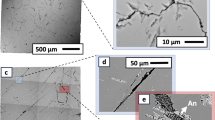Abstract
In the 6 component system CaO-MgO-Al2O3-SiO2-CO2-H2 with 9 solid phases (quartz, plagioclase, epidote, tremolite, talc, chlorite, magnesite, calcite, dolomite) and a fluid phase, all 17 possible fluid-absent reactions have been set up and balanced. Using molar entropy and volume data for the solid phases, these reactions are arranged in P-T space about the 8 possible fluid-absent invariant points after the method of Schreinemakers. Field observations in Ordovician greenschist facies basic volcanics at Sofala N.S.W., indicate that neither talc+epidote nor magnesite+calcite are stable under the conditions of metamorphism. Assuming these conditions to apply to the theoretical study here, the fluid-absent invariant points are arranged in a relative fashion with fluid-absent reactions subdividing P-T space into smaller areas.
A scheme which permits a fluid of composition \(0 \leqq X_{{\text{H}}_{\text{2}} {\text{O}}} + X_{{\text{CO}}_{\text{2}} } \leqq {\text{1}}\) (i.e. a fluid containing CO2 and H2O together with other components), is modeled by treating H2O as a mobile component independent of CO2, and by allowing \(U_{{\text{H}}_{\text{2}} {\text{O}}} - U_{{\text{CO}}_{\text{2}} }\) values that lie off the \(U_{{\text{H}}_{\text{2}} {\text{O}}} - U_{{\text{CO}}_{\text{2}} }\) locus of binary H2O-CO2. Taking into account that neither talc+epidote nor magnesite +calcite is to be permitted, the fluid scheme is used to set up and balance all 39 possible fluid-bearing reactions. These are then arranged about 20 valid fluid-bearing invariant points in \(U_{{\text{H}}_{\text{2}} {\text{O}}} - U_{{\text{CO}}_{\text{2}} }\) space after the method of Korzhinskii and Sehreinemakers.
A characteristic solid phase assemblage is defined for each P-T area using chemographic relations inherent from the fluid-absent boundary reactions. The fluid-bearing invariant points that have a solid assemblage compatible with the characteristic assemblage in a particular P-T area are stable within the P-T regime of that area. When these stable fluidbearing invariant points are arranged in a relative fashion in \(U_{{\text{H}}_{\text{2}} {\text{O}}} - U_{{\text{CO}}_{\text{2}} }\) space, they outline a fluid grid which can be used to study the possible effects of local variation in X fluid over the particular P-T regime.
Similar content being viewed by others
Abbreviations
- U :
-
chemical potential
- S :
-
entropy
- V :
-
molar volume
- n :
-
coefficient of a phase in a reaction
- X :
-
mole fraction
- T :
-
temperature
- P :
-
pressure
- F :
-
number of degrees of freedom
- C :
-
number of components
- p :
-
number of phases
- s :
-
solid
- θ :
-
slope of reaction
- 1:
-
quartz
- 2:
-
plagioclase
- 3:
-
epidote
- 4:
-
tremolite
- 5:
-
talc
- 6:
-
chlorite
- 7:
-
dolomite
- 8:
-
magnesite
- 9:
-
calcite
References
Boettcher, A. L.: The system CaO-Al2O3-SiO2-H2O at high pressures and temperatures. J. Petrol. 11, 337–379 (1970).
Burnham, C. W., Holloway, J. R., Davis, N. F.: Thermodynamic properties of water to 1000° and 10,000 bars. Geol. Soc. Am. Spec. Paper 132, 96 p. (1969).
Carmichael, D. M.: Intersecting isograds in the Whetstone Lake area, Ontario. J. Petrol. 11, 147–181 (1970).
Deer, W. A., Howie, B. A., Zussman, J.: An introduction to the rock forming minerals. 528 p. London: Longmans, Green and Co. 1966.
Fawcett, J. J., Yoder, H. S.: Phase relationships of chlorite in the system MgO-Al3O3-SiO2-H2O. Am. Mineralogist 51, 353–380 (1966).
Korzhinskii, D. S.: Physicochemical basis of the analysis of the paragenesis of minerals (translated from the Russian edition, 1957). New York: Consultants Bureau 1959.
Robie, R. A., Waldbaum, D. R.: Thermodynamic properties of minerals and related substances at 298.15° K (25.0° C) and one atmosphere (1.013 bars) pressure and at higher temperatures. U.S. Geol. Surv. Bull. 1259 (1968).
Trommsdorff, V.: Progressive metamorphism of carbonate rocks in the central Alps between Bernina and Simplon (German). Schweiz. Mineral. Petrogr. Mitt. 46, 2, 431–460 (1966).
Watts, B. J.: Geology of the Mt. Tennyson area, south of Yetholme, N.S.W. Proc. Linn. Soc. N.S.W. 94 (1), 81–99 (1969).
Zen, E-an.: Construction of pressure-temperature diagrams for multicomponent silicate system after the method of Schreinemakers—a geometric approach. U.S. Geol. Surv. Bull. 1225, 56 pp. (1966).
Zen, E-an.: Gibbs free energy, enthalpy, and entropy of ten rock forming minerals calculations, discrepancies, implications. Am. Mineralogist 57, 524–553 (1972).
Author information
Authors and Affiliations
Rights and permissions
About this article
Cite this article
Watts, B.J. Relationship between fluid-bearing and fluid-absent invariant points and a petrogenetic grid for a greenschist facies assemblage in the system CaO-MgO-Al2O3-SiO2-CO2-H2O. Contr. Mineral. and Petrol. 40, 225–238 (1973). https://doi.org/10.1007/BF00373787
Received:
Issue Date:
DOI: https://doi.org/10.1007/BF00373787




